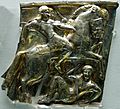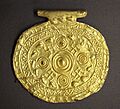Etruscan civilization facts for kids
The Etruscan civilization was an important ancient culture in Italy. It lasted for a very long time, from about 900 BC until 27 BC. The Romans called these people Etrusci or Tusci. The Ancient Greeks called them Tyrrhenoi. The Etruscans themselves used the name Rasenna.
This civilization started in prehistoric times. When it was at its strongest, it was made up of three main groups of cities, like modern states. These were Etruria, Latinum, and areas in the Po Valley and Campania. The Etruscans even ruled the city of Rome until 396 BC.
Etruscan Language
We don't know a lot about the Etruscan language. Not much of their writing has survived over time. Most of what we have found comes from words carved on tombstones. The Etruscans used an alphabet that was similar to those used in Phoenicia and Greece.
The Etruscan language is part of the Tyrrhenian language family. It is not clearly related to other languages we know today. Some Etruscan letters were later used by the Romans in the Latin alphabet. This Latin alphabet is now used in many languages, including English. Some Romans, like Cicero, could read Etruscan well, but few of their writings in Etruscan have survived.
Because there are not many Etruscan texts left, most of what we know about their society and culture comes from Roman writings that were made much later. Their politics were likely based on small cities and family groups. When they were powerful, rich Etruscans traded a lot. They traded with the Celtic people to the north and the Greeks to the south. They filled their large family tombs with fancy items they got from trade. Ancient Greek art and buildings had a huge influence on the Etruscans. They also knew a lot about Greek mythology.
Unlike Greek and Latin, the Etruscan language does not have any big literary works like famous books or plays that survived. However, we know they had religious writings. There is also some proof that they had historical stories and plays. For example, a playwright named Volnius was known for writing "Tuscan tragedies." We don't have any musical notes, but it's possible that Etruscan music was written down too.
Etruscan History
The Etruscans were skilled at mining metals like copper and iron. This made them rich and powerful. They traveled and traded all around the Mediterranean Sea.
The Etruscans started to lose their power in the 5th century BC. The Romans slowly began to conquer parts of Etruscan land. By the beginning of the 1st century BC, the Etruscans had been completely defeated by the Romans.
Etruscan Art
Etruscan art included many different types of creations. They made beautiful wall paintings, detailed metalwork, and sculptures from terracotta (a type of clay). Their cast bronze sculptures were very famous and were sold to many places. However, not many large bronze pieces have survived. This is because bronze was valuable, so it was often melted down and reused for other things.
Images for kids
-
Fresco of an Etruscan musician with a stringed instrument, found in the Tomb of the Triclinium, Tarquinia.
-
Etruscan riders, a silver panel from 540-520 BC, found near Perugia.
-
Sarcophagus of the Spouses, about 1st century BC, Volterra, Museo etrusco Guarnacci
-
The Capitoline Wolf, long thought to be an Etruscan bronze, showing the twins Romulus and Remus.
-
Sarcophagus of the Spouses, (Louvre, Room 18).
-
3D view, facing west, of the Etruscan Hypogeum of the Volumnis, Perugia, Italy, cut from a laser scan.
-
Janiform kantharos, Etruscan pottery, second half of the 4th century BC.
-
Samples of Etruscan script, from the Liber linteus.
See also
 In Spanish: Etruscos para niños
In Spanish: Etruscos para niños


















